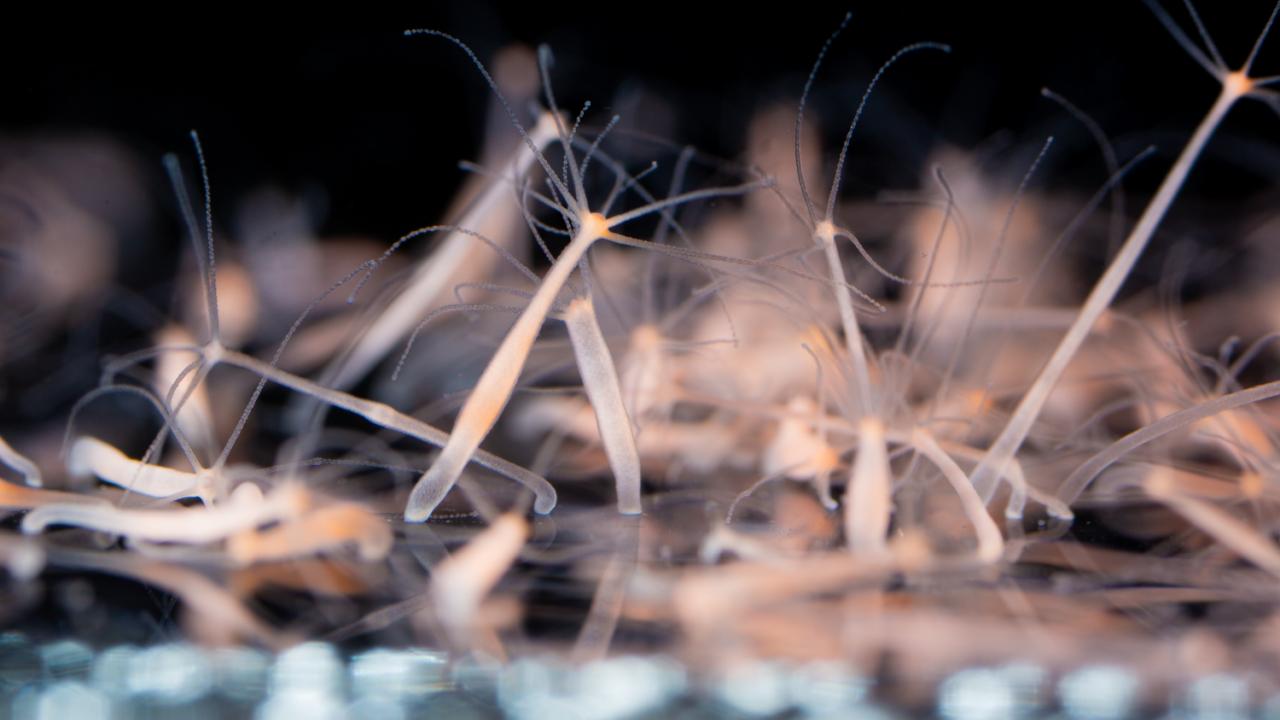
Mapping Cells in the “Immortal,” Regenerating Hydra
Quick Summary
- Researchers have used single-cell sequencing techniques to track the developmental trajectory of 25,000 Hydra cells
- The study gives researchers a high resolution “single-cell molecular map” of the three stem cell developmental lineages in Hydra
- Hydra stem cells exist in a continuous state of renewal, giving the organism biological immortality and regeneration capabilities
Unlike the stem cells of an adult human, the stem cells of an adult Hydra—a small freshwater invertebrate related to jellyfish and corals—are in a constant state of renewal, bestowing it with amazing regenerative capabilities and nearly biological immortality. Around 100,000 cells make up the Hydra body, and amazingly, these cells renew every 20 days thanks to the Hydra’s bottomless well of stem cells.
But how do these stem cells produce specialized cells in the animal, like neurons or skin cells? What genetic decision trees do Hydra stem cells use?
In a study appearing in Science, Assistant Professor Celina Juliano, Department of Molecular and Cellular Biology, and her colleagues used single-cell sequencing techniques to explore the genetic trajectory for nearly 25,000 Hydra cells. The study was led by Stefan Siebert, a project scientist in the Juliano Lab, in collaboration with Jeff Farrell, a postdoc at Harvard University.
“The beauty of single-cell sequencing and why this is such a big deal for developmental biologists is that we can actually capture the genes that are expressed as cells differentiate from stem cells into their different cell types,” said Juliano.
The study gives developmental biologists a high resolution “single-cell molecular map” of the three stem cell developmental lineages in Hydra.
Hydra “holds an informative position in the animal tree of life,” said Siebert. “Data sets like ours will help us to better understand important gene regulatory networks that were in place early in evolution and that are shared among animals and us.”
The research also provides the first gene expression map of the Hydra nervous system. Understanding how the Hydra regenerates its entire nervous system could help us better understand neurodegenerative diseases in humans and open the door to new therapies.

The three fountains of eternal youth

Hydra continuously renew their cells from three different stem cell populations, which are known as endodermal epithelial, ectodermal epithelial and interstitial cells. To trace the differentiation of individual stem cells, Juliano and her colleagues used a technique called Drop-seq, which was developed by the McCarroll Lab at Harvard University.
Using Hydra cells, barcoded beads and microfluidic devices, the researchers analyzed sets of messenger RNA molecules, called transcriptomes, from individual Hydra cells and grouped them together by cell type based on the genes each cell expresses.
“Single-cell sequencing is a game-changing technology and gives us access to information that is usually masked when sequencing whole tissues,” said Siebert. “Drop-seq is a very cost-efficient version of this type of protocol allowing us to analyze the cells of a whole organism.”
Juliano and her colleagues started Drop-seq runs on Hydra cells more than two years ago. An empty, celebratory champagne bottle sits on a shelf in Juliano’s office and marks the date of the lab’s first Drop-seq run, Feb. 24, 2017. Farrell wrote on the bottle, “Not a drop left.”

A cellular decision tree
Of the three different stem cell lineages in Hydra, Juliano said the interstitial lineage is probably the most interesting. Interstitial cells give rise to various cell types in Hydra, including neurons, gland cells, nematocytes (stinging cells in Hydra tentacles) and germ cells through a decision tree-like process.
“By building a decision tree for the interstitial lineage, we unexpectedly found evidence that the neuron and gland cell differentiation pathway share a common cell state,” said Juliano. “Thus, interstitial stem cells appear to pass through a cell state that has both gland and neuron potential before making a final decision.”
The single cell molecular map also allowed Juliano and colleagues to identify genes that may control these decision-making processes, which will be the focus of future studies.
“This project marked the beginning of what I’m sure will be a life-long interest in Hydra biology for me.” said Farrell. “It offered an exciting analytical challenge. Previously I’ve worked on developmental timecourses, but Hydra are constantly regenerating and all of differentiation is happening in a single sample, so our analysis had to uncover the hidden temporal information.”

Regenerating to combat injury and one day, human disease?
Juliano and her colleagues also provide more information about the Hydra nervous system in the study. Given the animal’s amazing regenerative capabilities—if you cut one in half, it’ll regenerate its body and nervous system in roughly two days—Juliano and her colleagues are curious about how the Hydra nervous system responds to injury.
“All organisms share the same injury response pathway but in some organisms like Hydra, it leads to regeneration,” said study co-author Abby Primack, a biochemistry, molecular, cellular and developmental biology graduate student. “In other organisms, like humans, once our brain is injured, we have difficulty recovering because the brain lacks the kind of regenerative abilities we see in Hydra.”
If the researchers can further understand and tap into this biological feat of limitless neurogenesis, it might help inform therapies and treatments for humans with neurodegenerative diseases.
Other UC Davis co-authors on the study include graduate student Jack Cazet and junior specialist Yashodara Abeykoon and Assistant Professor Christine Schnitzler, of the University of Florida.

